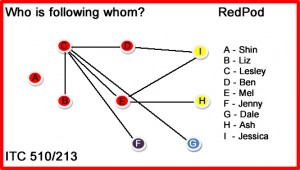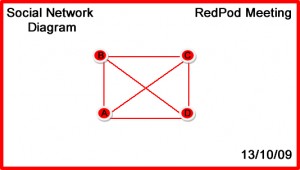CIO Recommendations
Using Social Networks for Professional Development
Before making recommendations regarding the use of social networks for Professional Development, we believe it essential to address three main areas common to these types of networks. This is important to ensure all staff involved has clear understandings of social networks before investigating tools that may be valuable for this purpose.
Issues involved with using social networks for professional development in the workplace.
Goals:
Successful professional development using social networking requires clear goals decided
upon by staff members from all levels. Goals should be evaluated regularly in order to ensure their achievement and relevance. It may be necessary, during such evaluation, to make changes to the goals or the methods being used to reach them, if either are deemed unsuccessful.
Policies and Rules:
These also need to be clear, and a sense of ownership and worth is created when all staff is involved. Rules and policies should be freely available - in hard copy and online form. Providing explicit rules helps maximise productivity and ensures accountability by increasing the likelihood that all employees remain on task, are aware of accepted best practice, expected standards of interaction and communication and personal responsibilities.
Trust:
- Initial training, should occur face-to-face involving members from all company levels allowing trust to be developed amongst staff from the beginning.
- Allowing time for more informal chat between members further develops elements of trust and confidence in all aspects of the network
- Involving all stakeholders in decision making and planning should occur in the initial stages and agreement reached regarding a time line for implementation
- All staff members should have a presence within the network, abide by rules and guidelines and be given the opportunity to comment, share talk and discuss. Doing this encourages collaboration, improves teamwork and demonstrates that everyone is valued.
- Following company policy, a clear distinction should be made between work-based and personal social networks with only members of the company staff joining the network or using appropriate tools if sensitive material is to be discussed.
- Staff should be acknowledged for using the networks and the achievements they make in Professional Development to help with group momentum.
Support:
- If social networks are to be implemented, reliable technical support must be constantly available to users.
- Support should also include offering of staff training to maximise use of the network and familiarity with it and any supplementary tools being used.
- Time also needs to be factored in as staff still requires time to access the social network to participate in the professional development or professional discussion.
- Differences across the company community should be catered for.
- Items such as
- distance and time zones,
- culture and language
- staff ages
- differing hardware available
- varying broadband speeds
- need full consideration if social networks are to be used effectively.
Security:
All measures should be put in place to ensure privacy and security for members of the network and any tasks they are working on. These should be laid down clearly within the company policies
Web 2.0 tools (blogs, wikis, podcasts and video lectures) used to complement social networks.
A variety of Web 2.0 tools are available to support the use of social networks we have listed some here:
- Blog sites are useful for adding announcements, scheduling meetings, new information or links to websites, uploading documentation - such as course outlines and expectations. Blogs can also be used as a way of keeping track of or up date with a project as it goes through development. Staff members should be encouraged to subscribe to RSS feeds for any of these sites in order to keep up with changes that may occur within them.
- A wiki can be used for collaborative writing of policy documents and submissions.
- Podcasts could be used for delivering tutorials or revising other professional development experiences and allows this to be done by staff members in their own time.
- Video lectures could be used to reach all members of the network and replace face to face meetings with experts when this is difficult in real-time due to distance or availability.
It is important to note that most social networking sites have a selection of Web 2.0 tools available for use.
Developing and sustaining a work-related social network.
To develop, establish and sustain a work related social network for professional development the following needs to be taken into account:
Planning considerations
- Good planning in the initial stages will set the tone for the development of and the ability to sustain the workplace network. Through liaison between working parties decisions are made about goals, professional development, use of personnel and scheduling.
Support Considerations
- Ongoing technical support is required ensuring the smooth running of the network.
- Support with the initial use of software - making sure all staff members have necessary skill in both hardware and software use.
- Setting aside of time for professional development within working hours
- Demonstration of support of the implementations to all workers by company executives.
- Acknowledgement of network members and their skills and achievements and how these will occur.
Budget considerations
- What the company’s budget is for the exercise - as this will have bearings on which social networks are implemented as well as their, development and sustenance.
- Costs to the company - as many social networks have extra costs associated with them to increase their functionality, these must be budgeted for.
Security considerations
- Differentiation between work-place and personal use of social networks should be clear
- Policies for which tools are suitable for particular tasks and communication need to be clearly stated and adhered to, with consequences in place for any breaches.
- The company must evaluate Risk vs. Reward - email is quicker than snailmail and has a quicker cyclical turnaround - instant messaging is quicker again yet all methods carry risks of ‘leaking’ sensitive information.
In providing professional development experiences for staff, we have found that there is no one ‘best’ option for the job. However, a ‘mashup’ of different applications may be the best viable option. In this regard, four social networking tools have been researched to determine the possibility of using these tools to provide professional development experiences for staff. We have listed below, our investigations into these social networks for your consideration:
Skype is software using VOIP(Voice Over Internet Protocol) to allow communication over the internet for free between users who have it installed. Skype allows computers, or other devices to become phones. Calls can also be made to landlines and mobile numbers at minimal cost beginning at 3.1 cents per call.
Skype software is free, easy to download, has an interface that is ‘user friendly’, and works across major operating systems and with most computers. It offers features such as instant messaging, one-way screen sharing, file transfer and audio/video conferencing. It would be an excellent tool, as is, for both local and global office communications. If sensitive information is being dealt with and security is to be considered, Skype can be switched through a telephone PBX system which will allow closer monitoring of calls and types of information being exchanged.
Second Life is a multi-user virtual environment where people log into a virtual world and take on virtual personas known as avatars. In the three dimensional environment users interact with each other either by text or audio. There are a variety of useful professional development tools available such as an instant chat facility, audio recording and playback and video and hypermedia presentation software. It is also possible to provide links to blogs, wikis and other internet sites. Second Life requires fast internet connections and up-to-date computers with good video cards and whilst Second Life enables professional development to occur with participants around the globe time zones can become a difficulty if collaboration is required. Setting up a work related Second Life network is very expensive with significant development and running costs.
Facebook is a global networking site where people can connect with others by sending messages and engaging in asynchronous chat. This is an advantage when connecting with people in different time zones. Facebook is relatively simple to use and provides the users with the capabilities of using a variety of different tools such as wikis, blogs and podcasting. In terms of using Facebook for professional development the advantage is that membership to a particular network is by invitation only - this is particularly useful when discussing sensitive issues online. A possible disadvantage of using Facebook for professional development is that employees may be tempted to use the social networking site for personal reasons during work time. To overcome this and to ensure worker productivity is not lost there would have to be a clear set of guidelines that is followed by all employees.
Ning is an online platform for people to create their own social networks around specific interests with their own visual design, choice of features and member data. With that in mind, it is a great starting point for a work-related social network. Its basic features include:
- A blog for each individual member of the Ning.
- A discussion forum.
- A photo upload feature.
- A basic chat room.
Beyond these features, Ning allows its network creators to add additional applications to their network that allow them to customise the network more in line with their users desires. As of May, 2009 additional applications have been made available to network creators, including wiki creation and TokBox, a live video chat service. By using Google’s OpenSocial API’s Ning has made application creation or porting to Ning easy for developers, turning an already well-rounded Web 2.0 application into the perfect vehicle for a knowledgeable and patient network creator to establish a work-related social network.


 alogue to compare with my original data.
alogue to compare with my original data. 